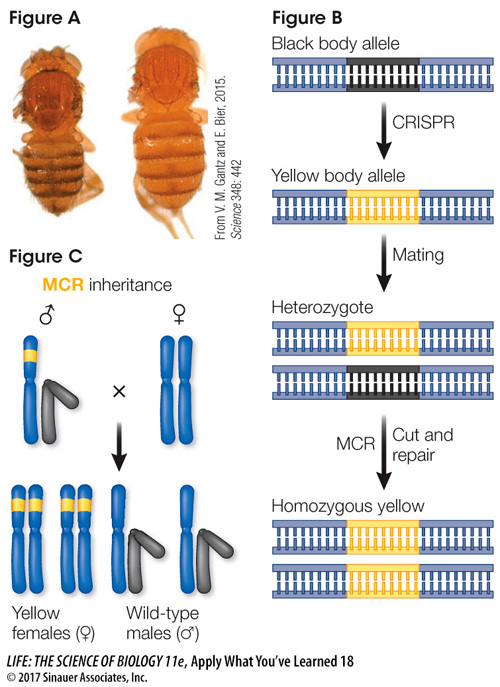Apply What You’ve Learned
Review
18.4 CRISPR technology can be used to alter and inactivate specific genes.
18.5 The use of biotechnology has ethical and environmental ramifications.
Original Paper: Gantz, V. M. and E. Bier. 2015. The mutagenic chain reaction: A method for converting heterozygous to homozygous mutations. Science 348: 442−444.
Mosquitoes in the genus Anopheles transmit the parasite Plasmodium to humans, resulting in more than half a million deaths from malaria every year. Some genetic strains of Anopheles carry a recessive gene that, when homozygous, makes them inhospitable to the parasite. Gene knockout methods have been used to produce large numbers of mosquitoes carrying the resistance mutation, but since only one of the two alleles is mutated by this method, release of these insects into the wild will not result in a rapid spread of malaria resistance. A method to mutate both alleles, producing mosquitoes homozygous for resistance, would result in a more rapid spread of resistance.
Gantz and colleagues developed a method called the mutagenic chain reaction (MCR) to address this. They used CRISPR technology to convert heterozygous mutations to homozygous ones in the model organism Drosophila melanogaster. The CAS9 enzyme was used to cut the body-
Figure C shows how MCR inheritance works. CRISPR technology created a male fly with the mutated yellow gene (marked in yellow on Figure B) on the X chromosome. When this fly was crossed with a homozygous wild-

Questions
Question 1
How do the genotypes in the CRISPR cross compare with those produced by sex-
The daughters all are homozygous for the transgene. Under Mendelian expectations, the daughters should be heterozygous.
Question 2
Why do none of the male offspring have the mutated allele?
The male offspring inherit their X chromosome from their mother. The female parent in this cross lacked the transgene.
Question 3
Explain why this method would result in a rapid increase in the frequency of the mutated alleles in the population if the flies were released to the wild.
Because the F1 females are homozygous for the transgene, they should produce male offspring that all have the transgene, regardless of their mate’s genetic makeup. Males have only one copy of the X chromosome. These males should then produce daughters that are all homozygous for the transgene. The cycle would continue, yielding more and more flies with the transgene.
Question 4
The researchers plan to use similar technology to fight malaria. What else would be needed to enable this technology to combat malaria?
Additional transgenes that inhibit malaria transmission would be needed. In actual practice, there are genes that cause the mosquitoes to be resistant to Plasmodium. Thus the mosquitoes would still bite humans, but the likelihood that they would transmit malaria would be reduced.
Question 5
What are some possible risks of this technology? How can these risks be minimized?
Because the technology is very powerful and CRISPR can theoretically be used in just about any organism, there is a legitimate concern about accidental release of the construct. Laboratory safety protocols are vitally important. The researchers have used stringent containment procedures in accordance with approval from their institutions.